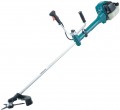ICE type
Scheme of operation of an internal combustion engine installed on a lawn mower. Note that this division is relevant only for gasoline engines (see "Engine type") — diesel engines are extremely rare and are made only four-stroke.
— 2-stroke. The main advantages of two-stroke engines over four-stroke ones are the simplicity of the device and higher power with the same working volume, due to which such units are lighter, more compact and cheaper. On the other hand, they consume more fuel and are distinguished by a high level of noise, and such an engine needs to be filled with a mixture of gasoline and oil in the correct proportion, which complicates maintenance somewhat (there are separate refueling systems, but they are complex and expensive, which is why they are almost never used ). As a result, this option is found mainly among trimmers (see "Type"): it is there that small dimensions and weight are decisive, and the required power and fuel consumption are relatively low.
—
4-stroke. Engines of this type are somewhat more complicated and more expensive than two-stroke ones; in addition, to achieve the same power, they need more volume, which affects the size and weight. On the other hand, if the engine does not need to be "carried in the hands" (as is the case with trimmers), these points do not really matter; and the difference in price, thanks to the development of technology, is becoming less and less noticeable. With a
...ll this, four-stroke engines are quieter and consume less fuel. As a result, almost all units where a relatively large and heavy internal combustion engine can be installed are equipped with this particular type of engine. And relatively recently, light and compact engines have appeared, suitable even for trimmers.Motor power
Lawnmower engine power expressed in horsepower. The common unit of power these days is the watt, but gasoline and diesel engines (see "Engine Type") are traditionally referred to as hp. Some units are easy to convert to others: 1 hp. approximately equal to 735 watts.
In general, the more powerful the engine, the more performant the mower is and the better it handles with heavy work such as cutting thick grass, bushes, etc. On the other hand, high power has a corresponding effect on fuel consumption, as well as the weight and price of the engine. In addition, it should be taken into account that different types of mowers (see "Type") differ in terms of power requirements. For example, among trimmers there are many models with a capacity of
0.7 – 1.3 hp., for gasoline lawn mowers, the minimum power is already in the range of
1.3 – 2 hp., and for
mowers,
at least 2.5 hp is required. . So you can only compare units of the same type in terms of power. Detailed recommendations for choosing a mower depending on its type and features of the planned work can be found in special sources.
Motor power
Lawnmower engine power expressed in watts. This designation is used absolutely for all electric models (see "Engine type"), and it is also often found in gasoline and diesel units along with horsepower (these units are clearly related, 1 hp is about 735 watts).
In general, the more powerful the engine, the more performant the mower and the better it will cope with heavy work such as cutting thick grass, bushes, etc. On the other hand, high power has a corresponding effect on fuel / electricity consumption, as well as the weight and price of the engine. In addition, note that the power requirements depend on the type of mower itself and its engine (see above for both). For example, for most
robots, the power
does not exceed 500 W — more, taking into account specialization, is not required, besides, otherwise the devices would turn out to be too bulky and heavy. Trimmers and lawn mowers of similar power are only electric, and the power limit for power tools is
2500 – 3000 W when powered from the mains and
1500 – 2000 W for battery models. But in gasoline tools, the minimum power is about
500 – 1000 W for trimmers and
1000 – 1500 W for mowers; the maximum value can exceed
4 kW.
Detailed recommendations for choosing a lawn mower d
...epending on its type and features of the planned work can be found in special sources.Fuel tank volume
The volume of the fuel tank in a gasoline or diesel mower (see "Engine type").
A large tank allows you to work longer without refueling, but an excessive increase in capacity affects the dimensions and weight of the entire unit. So manufacturers usually select this indicator taking into account the power and fuel consumption of a particular engine, and in general, the volume of the tank is not critical when choosing. However, knowing the tank capacity and fuel consumption (see above), you can estimate how much one refueling will approximately last.

